Apple iPhone 4S: Thoroughly Reviewed
by Anand Lal Shimpi & Brian Klug on October 31, 2011 7:45 PM EST- Posted in
- Smartphones
- Apple
- Mobile
- iPhone
- iPhone 4S
Camera Improvements
Arguably the second largest hardware change (with the A5 SoC being the first and largest) in the 4S is the inclusion of a much improved 8MP camera. In case you’ve forgotten, the iPhone 4 previously included a 5 MP camera. Back when the 4 was introduced, Apple talked for the first time about backside illumination, and pixel sizes. In a later update, the camera got even better with the ability to buffer three full size images and merge to HDR in real time. This time, Apple brought up F/# and backside illumination again, and added one more thing.
Though Apple never talked about any of their optical design for the iPhone 4 camera, to the best of my knowledge the design likely was close to reference designs reported on a few lens lists consisting of four plastic elements. For the 4S, Apple has mixed things up by including its own optical design front and center, and made special note of a five plastic element design. I’ve put together a table showing the 4 and 4S in comparison based on what information is available.
Note that many have speculated that Apple is dual sourcing the CMOS sensor which seems likely, and given the sensors out there the two most likely choices are Omnivision’s OV8830 and Sony’s IMX105. Both of these have almost identical specifications, including 1.4µm pixels, a 1/3.2“ format, and an improved backside illumination process over the previous generation wafer-scale process. Omnivision’s BSI–2 process cites some specifications that seem to line up with what Apple talked about in their presentation, including better quantum efficiency (ability to convert photons into electrons), low-light sensitivity, and larger well capacity (which translates to increased dynamic range). You’ll note that the 4S uses the same sensor format as the previous generation - 1/3.2”, and includes more pixels, which results in the pixel size going down from 1.75µm to 1.4µm.
| iPhone 4 vs. 4S Cameras | ||
| Property | iPhone 4 | iPhone 4S |
| CMOS Sensor | OV5650 | OV8830/IMX105 |
| Sensor Format | 1/3.2" (4.54 x 3.42 mm) | 1/3.2" (4.54 x 3.42 mm) |
| Optical Elements | 4 Plastic | 5 Plastic |
| Pixel Size | 1.75 µm | 1.4 µm |
| Focal Length | 3.85 mm | 4.28 mm |
| Aperture | F/2.8 | F/2.4 |
| Image Capture Size | 2592 x 1936 (5 MP) | 3264 x 2448 (8 MP) |
| Average File Size | ~2.03 MB (AVG) | ~2.77 MB (AVG) |
Everybody likes talking about sensors (and I see lots of attention given to them), but any good photographer knows that it’s a combination of optical system and sensor that matters to performance. Optical design is important, and having studied as an optical engineer I find it interesting that Apple would draw attention to having a custom design of their very own with an additional plastic element. For a while I’ve held off on really talking about smartphone camera optics, but while we’re here, let’s touch briefly on them.
Thus far this generation and the one before it have primarily used 4 plastic elements, and virtually everyone but Nokia uses nothing but plastic (Nokia famously uses Zeiss-branded designs, often with glass elements). Optical design is generally driven by material availability, and there are only a few optical grade (read: transmissive in the visible) thermoplastics out there - Styrene, Polystyrene, ZEONEX, PMMA (Acrylic) and so forth - the list is actually relatively short. Thankfully polystyrene and PMMA can be used to make something of an achromatic pair, with polystyrene as a flint, and PMMA as something of a crown. Plastic provides unique constraints as well though - coatings don’t stick well, not very many have great optical properties, they have a high coefficient of thermal expansion, high index variation with temperature (which oddly decreases with increasing temperature), and less heat resistance or durability among others. With all those downsides you might wonder why smartphone vendors use plastic, and that reason is simple - they’re cheap, but more importantly, they can be molded into complicated shapes. Those complicated shapes are aspheres, which are difficult to fabricate out of glass, and afford much finer control over aberrations using fewer elements, which is an absolute necessity when working with very little package depth.
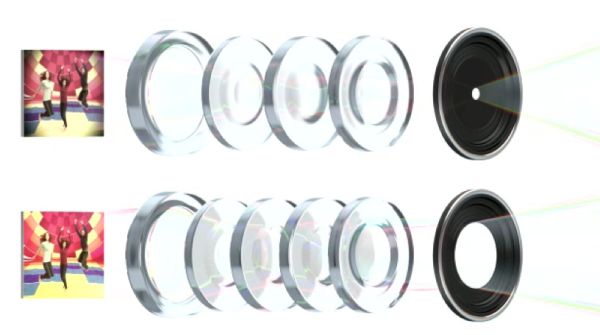 Apple's 4S versus 4 infographic
Apple's 4S versus 4 infographic
So what does adding another element get you? Well, when you’ve faced with limited material choices, adding more surfaces gives you another opportunity to balance aberrations that start blowing up rapidly as you increase F/#. That said, there are tradeoffs as well to adding surfaces - more back reflections, increased cost, and a thicker system. In the keynote, Apple notes that sharpness is improved by 30% in their new 5 element design, and MTF is what they’re undoubtably alluding to.
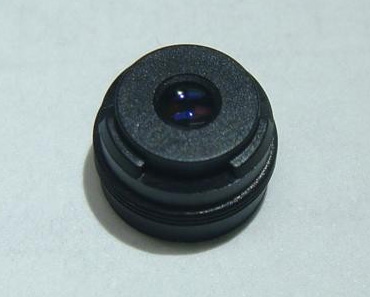
Genius electronic optical - 5P lens. Compare to above.
Genius electronic optical has a page on their website with a lens system that seems likely to be what’s in the 4S, as the specifications include 8 MP resolution (same size), same sensor format, F/# (2.4), 5 plastic elements (5P) and looks basically like what’s in the 4S. Other than that, however, there’s not much more that I can say about this Apple specific design without destructively taking things apart. One thing is for certain however, and it’s that Apple is getting serious about camera performance, something that other handset vendors like HTC (with its F/2.2 systems) are also doing.
Apple made mention that it also included an IR filter in the 4S optical design. If you recall back to our Kinect story, I used the 4 camera to photograph the IR laser structured light projector that Kinect uses to build a 3D picture. The 4 no doubt has an IR filter (though not a great one), but it’s probably just a thin film rather than a discrete filter right before the sensor. The 4S includes what Apple has deemed a ‘hybrid IR filter’ right on top of the sensor, which is possibly just a combination of UV/IR CUT filter (UV is a problem too), and an anti-aliasing filter.
If you try and take the same Kinect (IR source) picture with the 4S, thankfully all those non-visible, IR wavelength photons get rejected by the filter. This doesn’t sound like much until you realize that silicon is transparent in the IR and will bounce around off the metal structures inside a CMOS or CCD and create lovely diffraction effects on fancy sensors. I digress though since that’s probably not what Apple was trying to combat here. On a larger scale, IR will generally just cause undesirably incorrect color representation, and thus people stick an IR filter either in the lens somewhere or before the sensor, which is what has been done in the 4S. The thin film IR filters that smartphones have used in the past also are largely to blame for some of the color nonuniformity and color spot (magenta/green circle) issues that people have started taking note of. With these thin film IR filters, rays incident on the filter at an angle (as we move across the field) change the frequency response of the filter and the result is that infamous circular color nonuniformity. I wager the other effect is some weird combination of vignetting and the microlens array on the CMOS, but when I saw Apple make note of their improved IR filter my thoughts immediately raced to this ‘hybrid IR filter’ as being their logical cure for the infamous green circle the iPhone 4 exhibits.
Another minor difference on the 4S is that the LED flash is improved. The previous LED flash had a distinctively yellow-green hue, the LED flash on the 4S seems slightly brighter and also has a temperature that’s subjectively much closer to daylight, though I didn’t measure it directly. I habitually avoided using LED illumination on the 4 and will probably continue to do so on the 4S (and use HDR instead), but it does bear noting that the LED characteristics are improved. Unfortunately the diffuser and illumination pattern still isn’t very uniform or wide. It also seems that all this talk of moving the LED flash to the other side of the device to combat red eye turned out wrong as well.


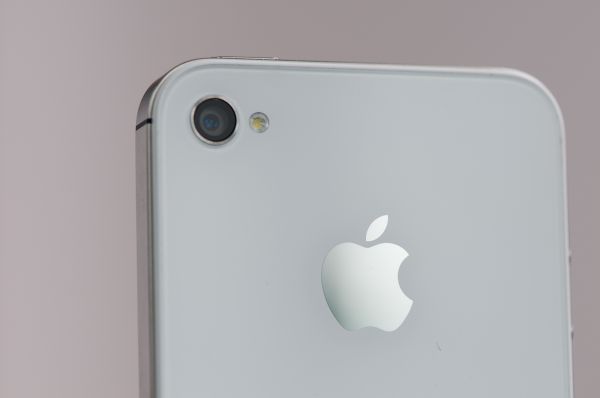
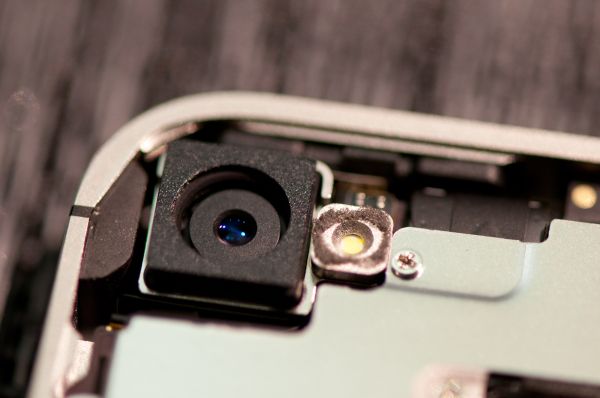
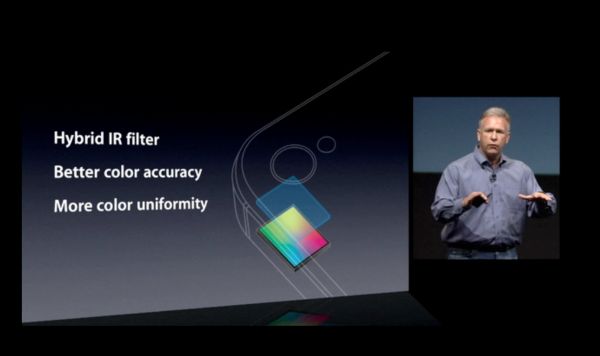








199 Comments
View All Comments
Formul - Monday, October 31, 2011 - link
There is about a dozen fairly similar android phones every month. As iPhone gets refreshed just once every year (this time year and a half) and has bigger market than any single android phone out there it makes sense to make the review thorough. I guess Nexus Prime and even Razer will get similar lengthy reviewsa ... as did many other android phones before that (galaxy s2 for example had about the same as this one).You are the one biased here. Counting the number of android articles on any gadget blog will seriously outpace the iPhone by far. You should shut up and read what you want, no one is forcing you to read this blog or any particular article on it. I dont read android articles, i dont care about android all that much. Why do you have to troll here if it does not interest you after all?
Anand Lal Shimpi - Monday, October 31, 2011 - link
I believe we did just that for the Galaxy S 2 review:http://www.anandtech.com/show/4686/samsung-galaxy-...
We don't have the RAZR, Galaxy Nexus or S2 Skyrocket, but we typically do a deep dive whenever there's a new platform transition or something truly unique to look at.
Take care,
Anand
LordSojar - Tuesday, November 1, 2011 - link
Hmm, touche Anand, I had forgotten about how detailed the S2 review was.The RAZR doesn't warrant a particularly detailed review I suppose, but I think the S2 Skyrocket might warrant a detailed antenna review etc considering the transition to LTE along with, what should be a major change to the antenna and should (I think) have QC's MDM9615 or MDM8215 chips in it... which is a big deal considering those could yield not only significant speed gains along with an antenna update, but some major throughput.
Cheers
doobydoo - Tuesday, November 1, 2011 - link
'Samsung releases a new phone that has overall better features, faster CPU, faster NAND, a different and arguably better (or at least equal) screen'I hope you are comparing to the OLD Samsung, in this sentence, rather than comparing to the iPhone 4S.
The CPU/GPU performance of the iPhone 4S is not comparable to the Galaxy S2, and I would argue the features are very much superior too.
Which, incidentally, along with the dual-antenna design, Siri, brand new camera, makes the iPhone 4S much more of a step up than the Samsung Galaxy to Samsung Galaxy S2. (The Galaxy S was about the same performance as the iPhone 4. The Galaxy S2 is slower than the iPhone 4S, therefore iPhone 4S is a bigger upgrade).
And of course, as Anand said, they thoroughly review most phones, and as the other poster says, the Android phones come out way more often so over the same length of time they get at least as much if not more coverage.
Tetracycloide - Tuesday, November 1, 2011 - link
The Galaxy S2 released in May. The 4S released in October. The next Galaxy phone, the generation the 4S is actually going to compete with, is the Galaxy Nexus. What I'm saying is your point would hold more water (or any at all) if Samsung didn't make 2 upgrades in the space of time it took Apple to do 1 so the differential between generations is hardly an apples to apples comparison (pun intended).thunng8 - Tuesday, November 1, 2011 - link
But the Galaxy Nexus isn't any faster than the S2. The main benefit is the new operating system and higher resolution screen.The Nexus is actually a significant step backwards from the S2 in terms of camera (likely from the samples on the prototype) and GPU (definitely since it is using the SGX540) performance
doobydoo - Wednesday, November 2, 2011 - link
Release dates will not stop phone users comparing the iPhone 4S to the Androids released in March 2012, just like they compared all the Androids over the last 17 months to the iPhone 4.The iPhone 4S, right now, is competing with the Galaxy S2 directly.
The Nexus Prime, as the other comment alluded to, is a significant downgrade from the Samsung Galaxy S2. Indeed, it uses the same GPU as used in the much older Samsung Galaxy S (albeit clocked higher).
The Galaxy S to S2 took approximately a year inbetween generations (June 2010 to May 2011), which is very much in line with the typical Apple release cycle of annually (this year was the exception). Even this year, with the extended timeline between iPhone 4 and 4S, Samsung didn't make 2 upgrades during that time. Your point would hold more water (or any at all) if it had.
Tetracycloide - Wednesday, November 2, 2011 - link
It's obvious you're not making a real comparison between current products but instead of admitting that you pretend it's a non-issue and then strangely fought that issue anyway by suggesting I'm not actually right to call you out on these shenanigans. So thanks for being obtuse about this, it makes it much easier to dismiss your position as that of an irrational fan-boy (at least it does when combined with the condescension in some of the other threads you've commented on here).doobydoo - Friday, December 2, 2011 - link
'It's obvious you're not making a real comparison between current products'Erm, huh?
That's EXACTLY what I'm doing.
What YOU'RE doing is asking is to compare a phone which isn't even out yet with a phone which is. You're trying to 'pretend it's a non-issue' that the phone you say the iPhone 4S should be compared with wasn't even out when this discussion started. THAT is the definition of fanboy-ism. It's like the constant like of Android fans 'x WILL be better when it eventually comes out' - and THAT is obtuse.
So, the only comments which can be dismissed are YOUR fanboy comments about 'x phone released in x months will be better'. Turns out you were wrong anyway, but that's irrelevant - the bottom line is you don't want iPhone to be compared to CURRENT Android phones, but instead compared to FUTURE ones.
Rational, much?
As it happens, it's out now, and isn't even much of an improvement on the Samsung Galaxy S2
Lucian Armasu - Wednesday, November 2, 2011 - link
The cameras seem to be about the same, according to Anand. I've actually found the SGS II camera to be a bit better in photo comparisons. Siri? I still think it's more of a gimmick for now. Maybe in 5-10 years it will be actually useful. Once the novelty expires, people will barely even use it in a few months. The same happened with FaceTime which everyone went crazy about at launch, and then they stopped using it completely.The CPU of the SGS2 IS faster than iPhone 4S CPU. There's no way Apple managed to get a 50% performance improvement for the same Cortex A9 chip that Samsung is using.
I think Anand can confirm this. He wasn't very clear in the review. He was only talking about the improvements it gets over the old Cortex A8.